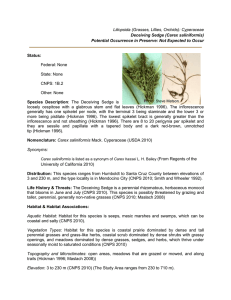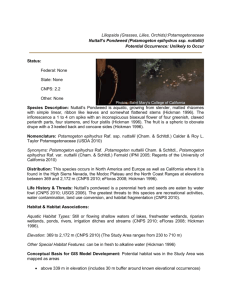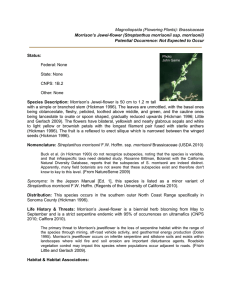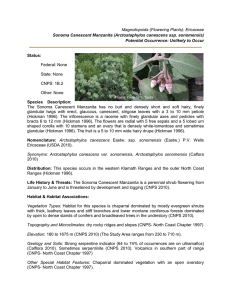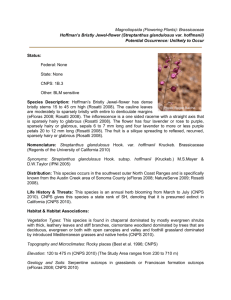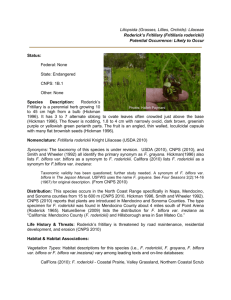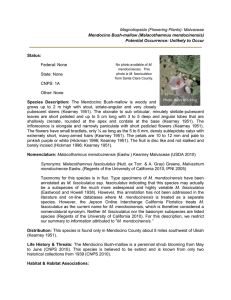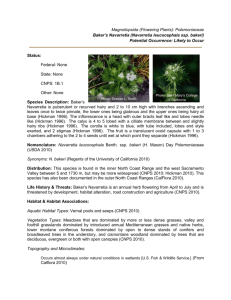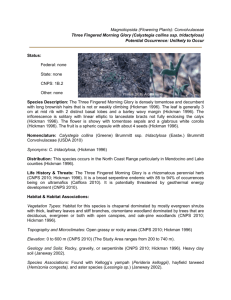ARSTR Text - Sonoma State University
advertisement
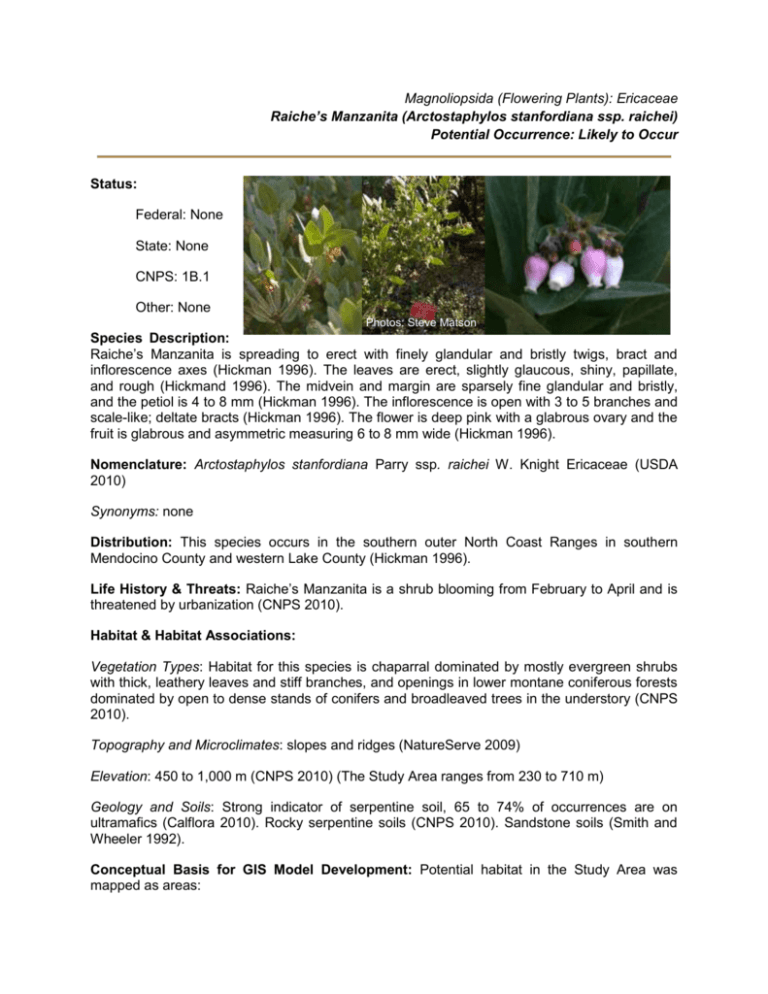
Magnoliopsida (Flowering Plants): Ericaceae Raiche’s Manzanita (Arctostaphylos stanfordiana ssp. raichei) Potential Occurrence: Likely to Occur Status: Federal: None State: None CNPS: 1B.1 Other: None Photos: Steve Matson Species Description: Raiche’s Manzanita is spreading to erect with finely glandular and bristly twigs, bract and inflorescence axes (Hickman 1996). The leaves are erect, slightly glaucous, shiny, papillate, and rough (Hickmand 1996). The midvein and margin are sparsely fine glandular and bristly, and the petiol is 4 to 8 mm (Hickman 1996). The inflorescence is open with 3 to 5 branches and scale-like; deltate bracts (Hickman 1996). The flower is deep pink with a glabrous ovary and the fruit is glabrous and asymmetric measuring 6 to 8 mm wide (Hickman 1996). Nomenclature: Arctostaphylos stanfordiana Parry ssp. raichei W. Knight Ericaceae (USDA 2010) Synonyms: none Distribution: This species occurs in the southern outer North Coast Ranges in southern Mendocino County and western Lake County (Hickman 1996). Life History & Threats: Raiche’s Manzanita is a shrub blooming from February to April and is threatened by urbanization (CNPS 2010). Habitat & Habitat Associations: Vegetation Types: Habitat for this species is chaparral dominated by mostly evergreen shrubs with thick, leathery leaves and stiff branches, and openings in lower montane coniferous forests dominated by open to dense stands of conifers and broadleaved trees in the understory (CNPS 2010). Topography and Microclimates: slopes and ridges (NatureServe 2009) Elevation: 450 to 1,000 m (CNPS 2010) (The Study Area ranges from 230 to 710 m) Geology and Soils: Strong indicator of serpentine soil, 65 to 74% of occurrences are on ultramafics (Calflora 2010). Rocky serpentine soils (CNPS 2010). Sandstone soils (Smith and Wheeler 1992). Conceptual Basis for GIS Model Development: Potential habitat in the Study Area was mapped as areas: above 420 m elevation (includes a 30 m buffer around known elevational occurrences of this species) chaparral (including scrub oak) coniferous forest (i.e. Redwood-Douglas fir mix (Sequoia sempervirens-Pseudotsuga menziesii) and Pacific Douglas fir (Pseudotsuga menziesii var.menziesii) vegetation types) with a multi-storied canopy We additionally mapped best potential habitat in the areas identified above as: roadsides. Note that road margins are the only GIS data layer with relevance to “openings” in vegetation, and other types of forest and chaparral openings could not be mapped. rocky soils (i.e., gravelly loam, cobbly loam, or alluvium) of sandstone (i.e., sandstone or greywacke) parent material ridges (0-13 deg on top of ridgelines) and slopes (> 7 deg) Serpentine soils, while common regionally, are not indicated by the GIS soil data as occurring in the Study Area. Potential Occurrence in the Galbreath Wildlands Preserve: Habitat: The best potential habitat in the Preserve for Raiche’s Manzanita is rocky sandstone soils on slopes and ridges in multi-story coniferous forests. Multi-story coniferous forest is extremely limited, with the largest contiguous patch on a steep rocky ridgeline in the northeastern corner of the Preserve. Roads were used as the best indicator of openings. However, not all roads are available in the GIS database and natural forest openings may also be abundant providing for an under estimation of best potential habitat within the very limited areas of appropriate vegetation. Potential habitat is poor to moderate. Raiche’s Manzanita occurrence is highly correlated with serpentine soils which, while common regionally, are not indicated by GIS soil data as occurring in the Galbreath Wildlands Preserve. To verify the GIS information, we identified all areas (11 sites) of exposed rocky soils from high-resolution satellite imagery. During site visits to these areas, the only serpentine found were rocks exposed by road maintenance activity at a waterbar. Raiche’s Manzanita is also commonly found in chaparral which also does not occur within Preserve boundaries. However, the all of the multi-story coniferous forests on the Preserve are on slopes, ridges, or are dominated by rocky sandstone soils and these areas may support this species. Nearest Occurrence: Documented Occurrences in the Galbreath Wildlands Preserve: Previous species list for the Galbreath Wildlands Preserve did not document this species (SSU Field Station and Nature Preserves 2010). Nearest Occurrence to the Galbreath Wildlands Preserve: Raiche’s Manzanita is known from 19 occurrences in Mendocino County and is also found in counties to the east (Lake) and south (Sonoma) of Mendocino (Calflora 2010). The majority of occurrences in Mendocino County are to the east of the Preserve (Calflora 2010) although two USGS quads in the northwest corner of the County also contain occurrences. The nearest documented occurrence is in the Yorkville quad in the Upper Russian River watershed (Calflora 2010). Summary: We anticipate this species to be “Likely to Occur” because, although potential habitat is poor to moderate in quality and highly limited in distribution, the species occurs nearby (relative to distances among other documented occurrences). References Calflora. 2010. Information on California plants for education, research and conservation.<http://www.calflora.org/>. Accessed 2010 Jul 11. California Native Plant Society (CNPS). 2010. Inventory of Rare and Endangered Plants. Online edition, v7-10b. <http://www.cnps.org/inventory>. Accessed 2010 Jul 11. NatureServe. 2009. NatureServe Explorer: An online encyclopedia of life [web application]. Version 7.1. <http://www.natureserve.org/explorer>. Accessed 2010 Jul 11. Hickman JC editor. 1996. The Jepson Manual Higher Plants of California. 3rd printing. London: University of California Press, Ltd. 557-8 p. Matson S. 2006. Arctostaphylos stanfordiana ssp. raichei. <http://calphotos.berkeley.edu/cgibin/img_query?rel-taxon=contains&where-taxon=Arctostaphylos+stanfordiana+ssp.+raichei>. Accessed 2010 Nov 8. Smith GL, Wheeler CR. 1992. A flora of the Vascular Plants of Mendocino County, California. San Francisco: University of San Francisco. 262 p. SSU Field Stations and Nature Preserves. 2010. Galbreath Wildlands Preserve Vascular Plant List. Compiled by CNPS Milo Baker Chapter, Linden Schneider, and others. <http://www.sonoma.edu/preserves/docs/galbreath_vascular_plants.pdf>. Accessed 2010 Jun. United States Department of Agriculture (USDA). 2010. PLANTS Profile. <http://plants.usda.gov/java/profile?symbol=ARSTR>. Accessed 2010 Oct 4. Species Account Description: Linden Schneider

